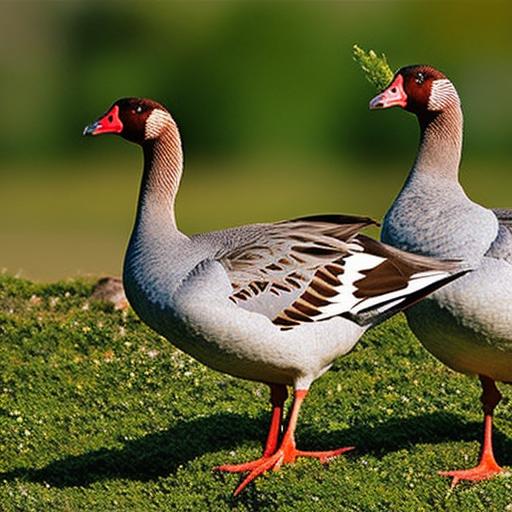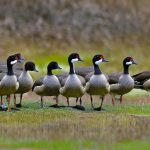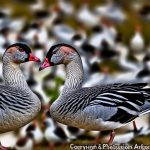Geese infestations can be a major problem for many communities and individuals. These birds are known for their aggressive behavior, loud honking, and large droppings, which can create unsightly and unsanitary conditions. Geese are also known to damage property, including lawns, gardens, and golf courses. Additionally, their droppings can pose health risks as they can contain harmful bacteria and parasites.
Controlling geese populations is important for several reasons. First and foremost, it helps to maintain the aesthetic appeal of an area. Geese droppings can quickly accumulate and create an unattractive environment. By controlling the geese population, communities can ensure that their parks, golf courses, and other public spaces remain clean and inviting.
Secondly, geese control is important for public health reasons. As mentioned earlier, geese droppings can contain harmful bacteria such as E. coli and Salmonella. These bacteria can contaminate water sources and pose a risk to human health. By implementing effective geese control measures, communities can reduce the risk of disease transmission.
Lastly, geese control is important for the protection of property. Geese are known to cause damage to lawns, gardens, and crops. Their feeding habits can destroy vegetation and their aggressive behavior can lead to property damage. By implementing geese control measures, property owners can protect their investments and prevent costly repairs.
Key Takeaways
- Geese control is important to prevent damage to property and potential health risks.
- Natural repellents like planting certain plants or using dogs can keep geese away.
- Physical barriers like fences or netting can create a goose-proof environment.
- Scare tactics like loud noises or visual deterrents can also be effective.
- Habitat modification like removing food sources or altering the landscape can make an area less attractive to geese.
Natural Repellents: The Best Ways to Keep Geese Away
One of the most effective ways to keep geese away is by using natural repellents. There are several natural methods that can be used to deter geese from an area. One such method is planting certain types of vegetation that geese find unappealing. Geese prefer open areas with short grass where they can easily spot predators. By planting tall grasses or shrubs, you can create an environment that is less attractive to geese.
Another natural repellent is the use of decoys. Geese are social animals and they tend to avoid areas where they see other geese. By placing decoys in strategic locations, you can create the illusion of a populated area and deter geese from settling there. It is important to move the decoys periodically to maintain their effectiveness.
When using natural repellents, it is important to consider the timing and placement. For example, planting tall grasses or shrubs should be done before the geese arrive in the spring. Decoys should be placed in areas where geese are likely to land or gather. By understanding the behavior and habits of geese, you can effectively use natural repellents to keep them away.
Physical Barriers: How to Create a Goose-Proof Environment
Physical barriers are another effective method for keeping geese away. Fencing or netting can be used to create a goose-proof environment. Fences should be at least three feet high and have small openings to prevent geese from squeezing through. Netting can be used to cover ponds or other water sources to prevent geese from landing.
When installing physical barriers, it is important to ensure that they are properly secured and maintained. Fences should be buried at least six inches into the ground to prevent geese from digging under them. Netting should be securely fastened and regularly inspected for any damage or gaps.
It is also important to consider the aesthetics of physical barriers. In some cases, fences or netting may not be visually appealing. In these situations, alternative options such as hedges or landscaping features can be used to create a barrier that is both effective and aesthetically pleasing.
Scare Tactics: Using Sound and Visual Deterrents to Keep Geese at Bay
Scare tactics can be an effective way to keep geese at bay. Geese are easily startled by loud noises and sudden movements. By using sound and visual deterrents, you can create an environment that is uncomfortable for geese and discourages them from settling in the area.
One common scare tactic is the use of noise makers. These can include devices that emit loud noises or mimic the sounds of predators. By placing these devices strategically, you can startle geese and encourage them to move on.
Visual deterrents can also be effective in deterring geese. Reflective tape or shiny objects can be hung in areas where geese are likely to gather. The movement and reflection of light can startle geese and make them feel unsafe.
When using scare tactics, it is important to regularly change the location or type of deterrent being used. Geese can quickly become accustomed to a specific scare tactic and it may lose its effectiveness over time. By regularly changing the tactics, you can maintain their effectiveness and keep geese at bay.
Habitat Modification: Altering the Environment to Make it Less Attractive to Geese
Habitat modification is another effective method for keeping geese away. By altering the environment, you can make it less attractive to geese and discourage them from settling in the area.
One way to modify the habitat is by removing food sources. Geese are attracted to areas where they can easily find food. By removing or reducing food sources such as grass clippings, fallen fruit, or bird feeders, you can make the area less appealing to geese.
Another way to modify the habitat is by altering the landscape. Geese prefer open areas with short grass where they can easily spot predators. By allowing grass to grow longer or planting tall grasses or shrubs, you can create an environment that is less attractive to geese.
It is important to note that habitat modification may take time to be effective. Geese are creatures of habit and it may take some time for them to adjust to the changes in their environment. Consistency is key when implementing habitat modification measures.
Electronic Repellents: Using Technology to Keep Geese Away

Electronic repellents can be an effective way to keep geese away. These devices use technology to deter geese from settling in an area.
One type of electronic repellent is motion-activated sprinklers. These devices are equipped with sensors that detect the presence of geese and activate a sprinkler system. The sudden burst of water startles the geese and encourages them to move on.
Another type of electronic repellent is lasers. These devices emit a laser beam that moves across the ground, creating the illusion of movement. Geese are startled by the movement and perceive it as a threat, causing them to leave the area.
When using electronic repellents, it is important to consider the placement and timing. The devices should be strategically placed in areas where geese are likely to gather or land. Additionally, the devices should be activated during times when geese are most active, such as early morning or late afternoon.
Professional Services: Hiring Experts to Manage Geese Infestations
In some cases, it may be necessary to hire professional services to manage geese infestations. Professional services have the knowledge and experience to effectively control geese populations and implement appropriate measures.
One benefit of hiring professionals is their expertise in geese behavior and habits. They can assess the situation and develop a customized plan that addresses the specific needs of the area. They can also provide ongoing monitoring and maintenance to ensure that the measures remain effective.
Another benefit of hiring professionals is their access to specialized equipment and resources. They have access to a wide range of tools and techniques that may not be readily available to individuals or communities. This allows them to implement more advanced and effective measures for geese control.
When choosing a professional service, it is important to consider their experience and reputation. Look for a service that has a proven track record of successfully managing geese infestations. Additionally, consider their approach to geese control and ensure that it aligns with your goals and values.
Education and Awareness: Teaching People How to Coexist with Geese
Education and awareness are important aspects of geese control. By teaching people how to coexist with geese, communities can reduce conflicts and promote a harmonious relationship between humans and wildlife.
One way to educate people is by providing information on geese behavior and habits. By understanding why geese behave the way they do, people can better understand how to prevent conflicts and minimize the negative impacts of geese infestations.
Another way to promote coexistence is by providing tips on how to discourage geese from settling in an area. This can include information on natural repellents, physical barriers, scare tactics, habitat modification, and electronic repellents. By providing practical solutions, communities can empower individuals to take action and effectively manage geese populations.
It is also important to raise awareness about the laws and regulations surrounding geese control. Many jurisdictions have specific laws in place to protect wildlife, including geese. By educating people about these laws, communities can ensure that geese control measures are implemented in a legal and ethical manner.
Legal Considerations: Understanding the Laws Surrounding Geese Control
When implementing geese control measures, it is important to understand the laws and regulations surrounding wildlife management. Many jurisdictions have specific laws in place to protect wildlife, including geese.
Before implementing any geese control measures, it is important to research and understand the laws in your jurisdiction. This may include obtaining permits or licenses for certain activities such as trapping or relocating geese.
It is also important to consider the ethical implications of geese control measures. While it may be necessary to implement measures to protect property or public health, it is important to do so in a humane and responsible manner. This may include using non-lethal methods or seeking alternative solutions.
By complying with the laws and regulations surrounding geese control, communities can ensure that their efforts are effective and ethical.
Finding the Right Solution for Your Geese Problem
In conclusion, geese control is an important issue that requires careful consideration and planning. There are several methods that can be used to effectively control geese populations, including natural repellents, physical barriers, scare tactics, habitat modification, electronic repellents, professional services, education and awareness, and legal considerations.
When choosing a solution for your specific geese problem, it is important to consider the unique characteristics of your area and the goals you wish to achieve. Consulting with experts or professionals can help you develop a customized plan that addresses your specific needs.
By implementing effective geese control measures, communities and individuals can maintain clean and inviting spaces, protect public health, and prevent property damage. With careful planning and implementation, it is possible to coexist with geese in a way that is both sustainable and harmonious.
If you’re looking for effective ways to keep geese away, you might also be interested in learning about the benefits of having a chicken coop in Chester, SC. Not only does it provide a safe and comfortable space for your chickens, but it can also serve as a deterrent for geese. Check out this informative article on poultrywizard.com to discover how a well-designed chicken coop can help keep unwanted geese at bay.
FAQs
What are some effective ways to keep geese away?
There are several effective ways to keep geese away, including using decoys, installing fencing, using repellents, and modifying the landscape.
What are some natural repellents that can be used to keep geese away?
Some natural repellents that can be used to keep geese away include grape concentrate, garlic, and hot pepper.
What are some non-lethal methods of keeping geese away?
Non-lethal methods of keeping geese away include using decoys, installing fencing, using repellents, and modifying the landscape.
What are some humane ways to keep geese away?
Humane ways to keep geese away include using non-lethal methods such as decoys, fencing, repellents, and modifying the landscape.
What are some reasons why geese may be attracted to a particular area?
Geese may be attracted to a particular area because of the presence of water, food sources, and suitable nesting sites.
What are some potential risks associated with geese?
Geese can pose a risk to human health through the transmission of diseases such as avian influenza and salmonella. They can also cause damage to property and pose a hazard to air traffic.
Meet Walter, the feathered-friend fanatic of Florida! Nestled in the sunshine state, Walter struts through life with his feathered companions, clucking his way to happiness. With a coop that’s fancier than a five-star hotel, he’s the Don Juan of the chicken world. When he’s not teaching his hens to do the cha-cha, you’ll find him in a heated debate with his prized rooster, Sir Clucks-a-Lot. Walter’s poultry passion is no yolk; he’s the sunny-side-up guy you never knew you needed in your flock of friends!







